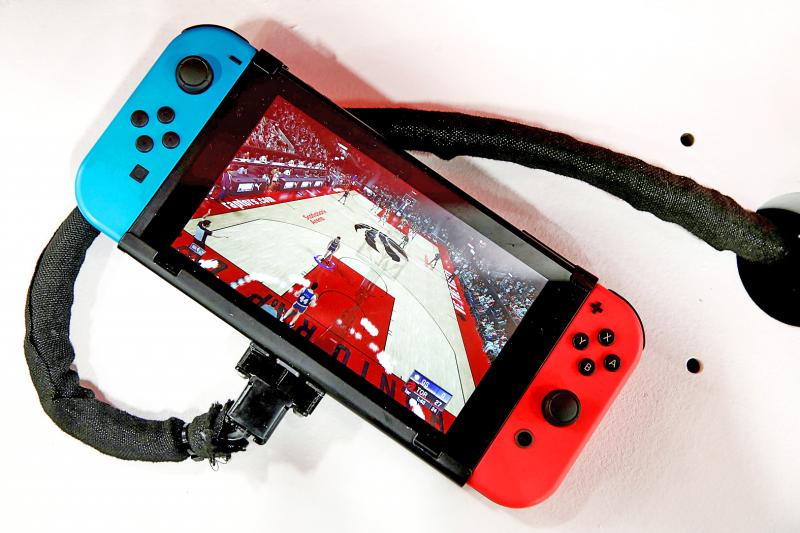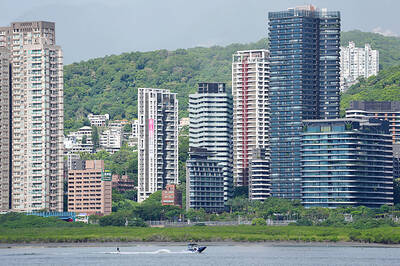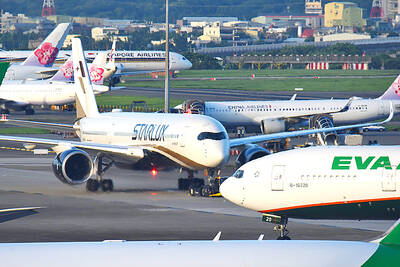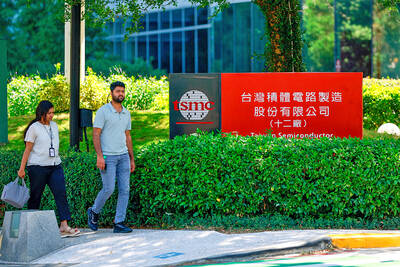Toshiba Corp said it would not be able to meet demand for power-regulating chips for another year and, in certain cases, through the end of next year, offering a fresh warning for makers of vehicles, consumer electronics and industrial machines struggling with component shortages.
“The supply of chips will remain very tight until at least September next year,” said Takeshi Kamebuchi, a director in charge of semiconductors at one of the company’s units. “In some cases, we may find some customers not being fully served until 2023.”
Material shortages and demand outpacing output capacity are to blame for Toshiba’s inability to fulfill orders for a component that does not require advanced production technology and has typically been deemed a commodity, Kamebuchi said.

Photo: Reuters
Mature tech such as Toshiba’s power chips is cheaper than cutting-edge memory and sensors, but no less important for any electronic device. If the processor is the device’s brain, power-regulating silicon and circuitry serve as the heart and vascular system, helping to smoothly transmit electricity.
Toshiba plans to invest ¥60 billion (US$545 million) in the three years to March 2024 to boost output of power semiconductors, Kamebuchi said.
Options beyond that period include additional investment that may include building another factory. Despite some investor concern that demand will evaporate after the pandemic-fueled frenzy for electronics, Kamebuchi said the company is confident that orders will keep growing rapidly enough to sell out all its production lines for years to come.
Automakers including Toyota Motor Corp and Volkswagen AG have had to halt or reduce production due to widespread chip shortages.
Kamebuchi said that some chip manufacturers are prioritizing automakers in their production and Toshiba is similarly making every effort to minimize the impact on auto assembly lines.
“We usually receive orders weeks and months in advance, but we currently face increasing inquiries for half a year into the future and beyond,” he said. “Long-term contracts piling up like this is new to us.”
Video-game consoles are another prominent victim of the power chip shortage. Sony Group Corp said it was still confident it can sell more than 14.8 million units of the PlayStation 5 this fiscal year to match the pace of its predecessor, but the new console’s production in the April-June quarter lagged behind the PlayStation 4’s for the same period.
Nintendo Co’s Switch production has not been sufficient to serve customer demand, Nintendo president Shuntaro Furukawa said.
The company intends to sell 25.5 million Switch units this fiscal year.
Game console production is vulnerable to a lack of components. Manufacturers are making daily calls to suppliers to ensure parts would reach assembly lines as promised, a top executive at an assembly contractor said.
Some console customers have told the assembler that they might alter their circuit board design to reduce the required components, the person said.
Toshiba is holding daily discussions on how best to allocate its limited output, with the company having to apologize to some customers for being unable to deliver in a timely fashion, Kamebuchi said.
“We consider which customer faces the most severe situation, such as the risk of the whole production line halting or the business getting obliterated without the supply of chips,” he said. “Game console makers are among the customers making the strongest demands and I’m sincerely sorry for their frustration as none of them have a 100 percent satisfaction.”

RECYCLE: Taiwan would aid manufacturers in refining rare earths from discarded appliances, which would fit the nation’s circular economy goals, minister Kung said Taiwan would work with the US and Japan on a proposed cooperation initiative in response to Beijing’s newly announced rare earth export curbs, Minister of Economic Affairs Kung Ming-hsin (龔明鑫) said yesterday. China last week announced new restrictions requiring companies to obtain export licenses if their products contain more than 0.1 percent of Chinese-origin rare earths by value. US Secretary of the Treasury Scott Bessent on Wednesday responded by saying that Beijing was “unreliable” in its rare earths exports, adding that the US would “neither be commanded, nor controlled” by China, several media outlets reported. Japanese Minister of Finance Katsunobu Kato yesterday also

Taiwan’s rapidly aging population is fueling a sharp increase in homes occupied solely by elderly people, a trend that is reshaping the nation’s housing market and social fabric, real-estate brokers said yesterday. About 850,000 residences were occupied by elderly people in the first quarter, including 655,000 that housed only one resident, the Ministry of the Interior said. The figures have nearly doubled from a decade earlier, Great Home Realty Co (大家房屋) said, as people aged 65 and older now make up 20.8 percent of the population. “The so-called silver tsunami represents more than just a demographic shift — it could fundamentally redefine the

China Airlines Ltd (CAL, 中華航空) said it expects peak season effects in the fourth quarter to continue to boost demand for passenger flights and cargo services, after reporting its second-highest-ever September sales on Monday. The carrier said it posted NT$15.88 billion (US$517 million) in consolidated sales last month, trailing only September last year’s NT$16.01 billion. Last month, CAL generated NT$8.77 billion from its passenger flights and NT$5.37 billion from cargo services, it said. In the first nine months of this year, the carrier posted NT$154.93 billion in cumulative sales, up 2.62 percent from a year earlier, marking the second-highest level for the January-September

‘DRAMATIC AND POSITIVE’: AI growth would be better than it previously forecast and would stay robust even if the Chinese market became inaccessible for customers, it said Taiwan Semiconductor Manufacturing Co (TSMC, 台積電) yesterday raised its full-year revenue growth outlook after posting record profit for last quarter, despite growing market concern about an artificial intelligence (AI) bubble. The company said it expects revenue to expand about 35 percent year-on-year, driven mainly by faster-than-expected demand for leading-edge chips for AI applications. The world’s biggest contract chipmaker in July projected that revenue this year would expand about 30 percent in US dollar terms. The company also slightly hiked its capital expenditure for this year to US$40 billion to US$42 billion, compared with US$38 billion to US$42 billion it set previously. “AI demand actually